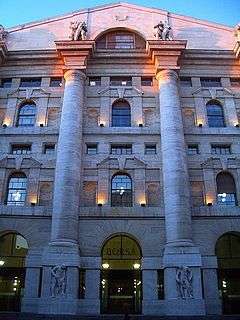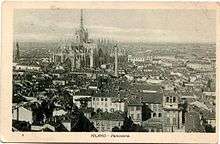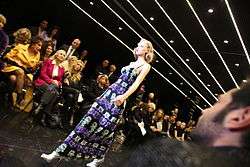Economy of Milan
Milan is the capital of the Lombardy Region in Northern Italy and is the wealthiest among Italian cities. Milan and Lombardy had a GDP of €400 billion ($493 billion) and €650 billion ($801 billion) respectively in 2017.[1] Milan has surpassed Berlin in economy in 2014, which since then has made it the richest city among the Four Motors for Europe. It is a member of the Blue Banana, the economic leaders of Europe.

Milan's hinterland is Italy's largest industrial area. Milan also has Italy's highest GDP per capita, about €49,500 (US$55,600).[2]
Milan's Porta Nuova District is Europe's richest subdivision within any city, with a 2016 GDP of €257 billion ($308 billion) similar to that of the world's 34th richest country, Philippines. The city center also houses Europe's most expensive street, Via Montenapoleone and the National Stock Exchange, Borsa Italiana.
Milan is considered as one of the fashion capitals of the World together with New York, Paris, and London.[3] Major fashion houses and labels, such as Versace, Gucci, Armani, Valentino, Prada, Dolce & Gabbana, Moschino, Luxottica, OVS, Tod's, Trussardi, and Missoni are headquartered in Milan.
Milan was Europe's most expensive city in 2015 and 2016 for hotel rates above 3 stars.[4] Milan is the world's 11th most expensive city for expatriate employees[5] and its influence in fashion, commerce, business, banking, design, trade and industry makes it a global city.[6]
Economic history

Since the late 12th century, Milan has been a wealthy and industrious city with the production of armours and wool. During the Renaissance, Milan was a center of production of luxury goods, textiles, hats and fabrics, along with Venice, Rome and Florence. The English word millinery, referring to women's hats in the 19th century, came from the word Milan. Towards the late 19th and early 20th centuries, Milan became a major European industrial centre for the automotive industry, chemicals, textiles, tools, heavy machinery and book and music publishing, with thousands of companies already headquartered in the city. After the city's World War II bombings and the opening of the Milan camp for refugees, the city witnessed an "economic miracle", with new buildings being built (such as the Pirelli Tower), more industries opening up and hundreds of thousand of immigrants from Southern Italy migrating to the city. Beginning in the 1980s the city experienced a strong flow of immigrants, and became a major international and cosmopolitan centre for expatriate employees. A study showed that by the late-1990s, more than 10% of the city's workers were foreigners.[7] According to the Italian National Institute of Statistics (ISTAT), 181,393 foreign-born immigrants lived in the city in January 2008, representing 13.9% of the total population.[8]
Production and sectors
Milan had a strong industrial and economic production after the war, however, it fell slightly in the late 1990s and early 2000s, especially with the tangentopoli political scandal. However, from 2004 onwards, economic growth started to increase again, with an average of 1%, below Lombardy (whose growth rate was 4.6%) and the Italy's 2004 6% average, and a significant reduced production in some industries: footwear (-11.4%), textiles (-6.1%) and clothing (-5%). The bulk of the plastic (-2%), chemicals (-1.8%) and mechanics (-1.6%) industries show a downward trend. Publishing production decreased by -2.6%, while the wood-processing industry production decreased by -1.2%. In contrast, despite an industrial decrease in production, Milan has had a rapid and strong growth in the tertiary and quaternary sectors, with logistics and transport (+6.8%) and food (+1.7%). Milan also has an important role in book production and publishing. It is the most important city in the nation for publishing.[9]
Banks and other services
Banks throughout Italy went through many changes in the late 1800s to early 1900s. One of the Milanese banks, the SBI, had many issues resolving its resources. It did not have support from foreign banks nor enough savings domestically. Other banks during this time in Italy, specifically during the 1907 international crisis, had high liquid assets and would have had to go bankrupt without the help from Banca d'Italia. A group of industrialists and bankers from Milan transformed the banking institute Figli di Weil Schott e C. into the Società Bancaria Milanese.[10]
Most traditional industries have relocated to other locations other than cities or have even closed down since the late 1970s in Italy. However, Milan, became Italy's most successful postindustrial city. Milan's service sector has benefited from the efficiency of the city's banks and the stock market, the Borsa Italiana located in Piazza degli Affari in the centre of the city. The majority of the services revolve around the Fashion industry, but the city is also a world centre of design at whole. There are specialties in the city in furniture design, graphic design, among other specialties. The design industry is centrally located to the Besana in the Brianza area north of the city. Communications is also a major service sector of the city. Milan is home to Mondadori, one of Italy's largest publishing group. In addition, the newspapers Corriere della Sera and La Gazzetta dello Sport along with the newsmagazine L'espresso.[7]
Porta Nuova is the main business district of Milan, and one of the most important in Italy. AXA, Bank of America, BNP Paribas, China Construction Bank, FinecoBank, Finanza & Futuro Banca, FM Global, HSBC, KPMG, Mitsubishi UFJ Financial Group, UniCredit, UnipolSai and many other companies have their headquarters in Porta Nuova.
Milan's service sector has benefited from the efficiency of the city's banks and the stock market, the Borsa Italiana, located in Piazza degli Affari in the centre of the city.[11]
Exports, imports, and trade
Milan's main trading partners are Switzerland, Russia, Turkey and the European Union (especially other Italian cities). In non-European trade, the main trading, exporting and importing partners are China, Hong Kong, the countries of North Africa, Singapore and United Arab Emirates. The city's main export products are electronics, electrical engineering, steel, textile and clothing products and motor vehicles (which, however, has dropped drastically in 2005 by 28.6%). On the import side of things, the main partners in Milan South Korea, Thailand, India, China, Hong Kong, Taiwan, and Japan. The imported goods from around 86% of these countries. Also, the city imports a significant amount from South American countries and the European Union (Germany, Belgium, Netherlands are the main partners)
Employment
Employment in Italy is linked to manufacturing as it has been seen that when there are technological changes in place, there is typically a positive effect on job growth; therefore, on employment rates. This was seen in the late twentieth century in the country as a whole.[12]
There is a steady workforce in the city of Milan due to the presence of new graduates from the five major universities located in the city. In the province, there are 1.6 million individuals employed, and about twenty five percent of that population are recorded as self-employed. The unemployment rate in Milan is recorded to be less than half of the national average, at about 4.6% in 2001.[13]
In 2011, the unemployment rate of the city of Milan was recorded to be 5.8%, which is much lower than the entire nation of Italy's unemployment rate being at 8.4% in that year.[14] Today, the unemployment rate in all of Europe is much higher, and in January 2014, the unemployment rate in Italy rose to 12.9% from 12.7% from December, which was the highest growth since 1977 in the nation, the entire nation was affected by this job loss and growth in rate of unemployment.[15]
Fashion

Since 2009, Milan is regarded as the world fashion capital, or formally "Capital of Fashion Capitals," ruling New York, Paris, Rome and London.[3] Most of the major Italian fashion brands, including Valentino, Gucci, Versace, Prada and Dolce & Gabbana, are currently headquartered in the city. Milan also hosts a fashion week twice a year, just like other international centres such as Paris, London, Tokyo, New York, Los Angeles and Rome.
Italian Ready-to-Wear has grown tremendously in Milan, in addition to the Fashion industry on a general note. Many economists don’t pay a great deal attention to the fashion sector of the business in Milan. However, there is a great deal of quantitative weight being held by the fashion industry in terms of the economy of Milan, yet not much research has been conducted by historians or economists. The industrial center of Milan had been creating textiles and clothing for centuries, but it became an international superstar of fashion in 1970, and a leading international fashion hub or center.[16]
Companies in Milan
Milan is home to many of Italy's major corporations, and 27 of the world's 100 largest companies, including Italy's largest bank (UniCredit) and the world's biggest eyewear company (Luxottica) are headquartered in the Lombard metropolis.[17] Other major Milan-based corporations and banks include Luxottica, Borsa Italiana, Telecom Italia Mobile (TIM), Intesa Sanpaolo, Banca Popolare di Milano, Vodafone Italy, Odeon TV, Fininvest, Edison, Esselunga, FinecoBank, Versace, Gucci, La Rinascente, OVS, Alfa Romeo, Prada, Etro, Pirelli, Compagnia Generale di Elettricità, 10 Corso Como, Valentino, Armani, Missoni, Moschino, Telelombardia, RCS MediaGroup, Anfatis SpA and BBPR.[18]
Tourism
3.jpg)
Milan is one of EU's most important tourist destinations; with 1.902 million arrivals in 2007 and 1.914 million in 2008, it places itself 42nd and 52nd respectively, most visited city in the world.[19] According to a particular source, 56% of international visitors to Milan are from Europe, whilst 44% of the city's tourists are Italian, and 56% are from abroad. The most important European Union markets are the United Kingdom (16%), Germany (9%) and France (6%).
According to a study, most of the visitors who come from the USA to the city go on business matters, whilst Chinese and Japanese tourists mainly take up the leisure segment. The city boasts several popular tourist attractions, such as the city's Duomo and Piazza, the Teatro alla Scala, the San Siro Stadium, the Galleria Vittorio Emanuele II, the Castello Sforzesco, the Pinacoteca di Brera and the Via Montenapoleone. Most tourists visit sights[21] such as Milan Cathedral, the Castello Sforzesco and the Teatro alla Scala, however, other main sights such as the Basilica di Sant'Ambrogio, the Navigli and the Brera district are less visited and prove to be less popular.
Results from the same study also say that 60% of tourists who visit Milan are male, whilst 40% are female. Over 58% of visitors travel by air, and 26% by car.
The city also has numerous hotels, including the ultra-luxurious Town House Galleria, which is the world's first seven-star hotel according to Société Générale de Surveillance (five-star superior luxury according to state law, however) and one of The Leading Hotels of the World.[22] The average stay for a tourist in the city is of 3.43 nights, whilst foreigners stay for longer periods of time, 77% of which stay for a 2-5 night average.
Green economy
In addition to Milan being regarded as one of the major fashion capitals of the world, being home to many services, banks, and industries, the city has also become important to the world of environmental matters and energy issues. It is home to about 350 companies that are active in areas of interest such as, water, energy efficiency, air, external noises, energy from renewable sources and hydrogen. In addition, the metropolitan city holds some of these companies that have components of research and development (about 30% of the companies) and is one of the most active areas in terms of patents for energy efficiency [14]
In fact, in July 2014, the city of Milan hosted the first meeting of the European Employment and Environmental Ministers. Milan, looking to create new jobs for the nation with a rising unemployment rate, and have many of these jobs be in the environmental sector, such as those employment areas being linked to renewable energy, energy efficiency, development of green infrastructure, as well as waste reduction.[23]
References
- "Territorial economic accounts. Value of the main aggregates (1). Total value - Regional - RSY Lombardia". www.asr-lombardia.it. Retrieved 27 November 2017.
- "Prodotto interno lordo". Comune di Bologna. Retrieved 31 December 2019.
- "The Global Language Monitor » Fashion". Languagemonitor.com. 8 February 2011. Archived from the original on 1 November 2009. Retrieved 29 April 2010.
- "Milan Ranks as Most Expensive City in Europe in 2015". Businesswire. 15 September 2015. Retrieved 10 September 2017.
- "Cost of living - The world's most expensive cities 2009". City Mayors. 7 July 2009. Retrieved 29 April 2010.
- "The World According to GaWC 2010". 14 September 2011. Archived from the original on 10 October 2013. Retrieved 3 February 2014.
- "Archived copy". Archived from the original on 5 November 2014. Retrieved 5 November 2014.CS1 maint: archived copy as title (link)
- "Statistiche demografiche ISTAT". Demo.istat.it. Retrieved 29 April 2010.
- Forgacs, David, and Stephen Gundle. Mass Culture and Italian Society from Fascism to the Cold War. Indiana University Press, 2007.
- The Economic History of Italy 1860-1990
- "Milan - Italy". britannica.com.
- Innovation and Employment: Evidence from Italian Microdata, Mariacristina Piva and Marco Vivarelli, Journal of Economics, Vol. 86, No. 1 (October 2005), pp. 65-83
- "Milan - Overview". USA Today. 19 May 2009.
- "Assolombarda - Assolombarda". Assolombarda.it.
- Totaro, Lorenzo (28 February 2014). "Italy Unemployment Rises to Record High in Challenge for Renzi". Bloomberg.
- Turning Fashion into Business: The Emergence of Milan as an International Fashion Hub, Elisabetta Merlo and Francesca Polese, The Business History Review, Vol. 80, No. 3 (Autumn, 2006), pp. 415-447
- "The World's 2000 Largest Public Companies". Forbes. 29 March 2006. Retrieved 29 April 2010.
- http://expo-magazine.com/inside.asp?p=566 Archived 5 November 2014 at the Wayback Machine)
- "Euromonitor Internationals Top City Destinations Ranking > Euromonitor archive". Euromonitor International. 12 December 2008. Retrieved 29 April 2010.
- "places to go in milan". Archived from the original on 2 April 2015. Retrieved 27 February 2015.
- "Heaven at Milan's Town House Galleria hotel". Melbourne: The Age. 7 January 2009. Retrieved 21 January 2009.
- "Green growth and employment: the future of the European economy arrives to Milan". italia2014.eu.
